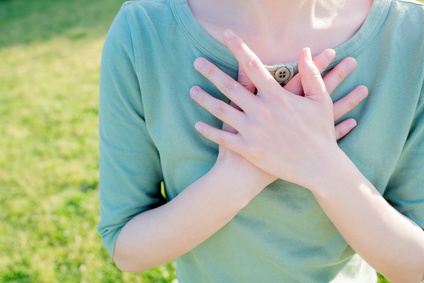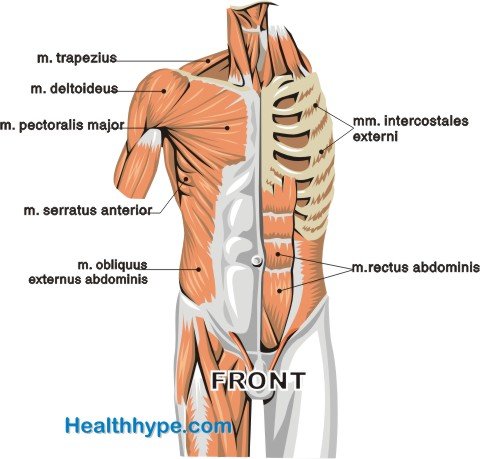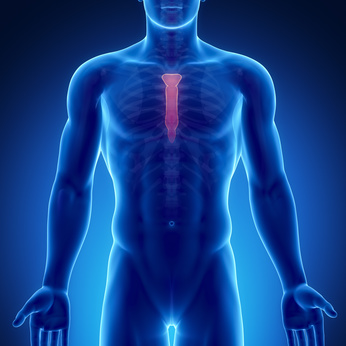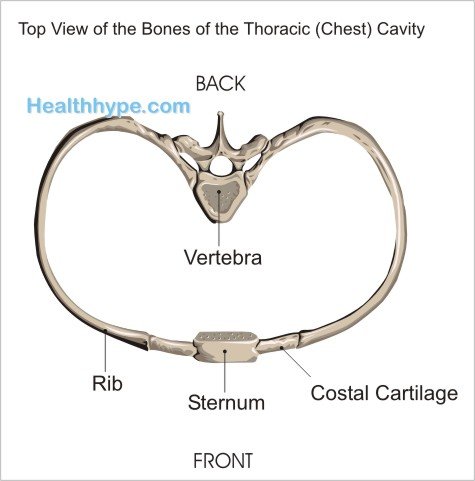Chest Wall Pain (Muscle, Bone, Skin) Causes of Pain on the Chest
The chest wall is composed of skin, subcutaneous tissue. muscles, bones that make up the rib cage and fascia of the anterolateral aspects of the thorax. The same structures that lie posteriorly (towards the back) are considered as part of the back and not as the chest wall. Within the wall lies a number of nerves, blood and lymphatic vessels, cartilage and joints.
The structure of the chest wall allows it to be flexible so that it expands and contracts during breathing and absorbs the force of a blow. At the same time, it is rigid enough not to collapse due to the negative pressure within the pleural cavities, support the upper limbs, neck and head, protect the inner organs of the thorax and serves as a point of attachment for a number of muscles of the upper limb.

Other Symptoms
One or more of the symptoms below may accompany chest wall pain.
- Difficulty breathing due to the pain upon inspiration and expiration
- Tenderness – sensitivity/pain upon applying pressure on the affected area
- Pain when moving upper limbs, changing position, deep breathing
- Skin patches – redness, darkening, rash
- Areas of swelling or lumps on the chest wall
Coughing, nausea, vomiting, shortness of breath and dizziness needs to be investigated immediately.
Causes of Chest Wall Pain
Skin
This includes the subcutaneous tissue.
- Acne
- Sunburn
- Trauma – hematoma
- Cellulitis
- Paresthesia
A number of skin diseases may also contribute to chest wall pain, often along with itching and a various types of skin rashes.
There are a host of pathologies that may result in breast pain. The breasts are modified skin appendages and are an important consideration of chest wall pain, especially in women (refer to Female Breast).
Some of the causes of chest wall pain related to the breasts includes :
- Trauma
- Mastitis
- Breast abscess
- Breast cancer
- Menstruation
- Pregnancy
- Breast milk engorgement
Muscles
The larger muscles on the chest wall are primarily responsible for upper limb movement and the pain would be more prominent upon moving the limbs. These muscles may also contribute to chest wall movements to some degree, especially during labored breathing.
- Muscle strain – overuse, weight bearing, persistent coughing, retching and vomiting
- Torn muscle
- Trauma
- Fibromyalgia
- Myositis :
- Infectious – Cosackie B virus (Bornholm’s disease), cytomegalovirus (CMV), Mycoplasma bacteria, Streptococcus pneumonia, toxoplasmosis, schistomsomiasis.
- Non-infectious – polymyalgia rheumatica, dermatomyositis.
- Myopathy due to drugs like statins and alcohol.
Bone
Breastbone (sternum), ribs (12 pairs) and clavicle (collarbone).
- Fractures
- Osteoporosis
- Trauma
Nerves
- Nerve root compression
- Shingles (Herpes zoster)
- Diabetic neuropathy
- Referred pain
Cartilage and Joints
- Costochondritis
- Tietze’s syndrome
- Rheumatoid arthritis
- Various causes of joint pain
Chest Muscle Pain
The wall of the chest cavity is made up of many muscles which attach to the bones or ligaments of the chest. These muscles are not only responsible for movement of structures within the thorax (chest cavity) and may also play a part in head, neck, upper limb and abdominal movement.
Any muscular chest pain that is aggravated by certain movements will assist your doctor in identifying which of these muscles may be injured. Ligaments and tendons may also be responsible for the pain. The diaphragm is the flat muscle that lies at the bottom of the thoracic cavity. It separates the contents of the chest from that of the abdomen and is a major muscle of respiration. At times, muscle-related chest pain may only be noticed upon movement or breathing or persist even upon rest.
Muscles of the Chest
There are large and small chest muscles some of which lie superficially and others are located deeper. If you are experiencing muscular chest pain that seems more localized to a specific area, then it is important to know which of the muscles in this area may be responsible.

- The pectoralis muscles include the pectoralis major and pectoralis minor. These muscles are often referred to as the ‘pecs’ and lie under the breast. The pectoralis major is a large muscle that lies more superficially while the pectoralis minor muscle lies underneath it, more towards the sides of the chest. Pain from these muscles are sometimes mistaken for breast pains.
- The serratus anterior muscle is located on the side and slightly to the front of the chest cavity.
- The intercostal muscles are located between the ribs.
- The rectus abdominis muscle is an abdominal muscle that is known as the ‘six pack abs’ when it is well developed. The upper part of this muscle lies on the bottom middle part of the chest wall.
- The external abdominal oblique muscle or ‘side abs’ lies on the lower part of the chest cavity crossing to the sides. There are also the internal abdominal oblique muscles which lie underneath the external oblique muscles.
Other large and small muscles lying on the chest wall may also be involved but may be difficult to isolate without medical investigation.
- If the muscular chest pain increases when moving the upper limb (arm), then this is more likely due to the pectoralis major or serratus anterior muscles.
- If the chest pain increases when sitting up from a supine (lying flat) position, when rotating the chest or while walking, then it may be due to the rectus abdominis or abdominal oblique muscles.
- If the chest pain increases when breathing this can involve many muscles including the diaphragm, intercostal, pectoralis minor, rectus abdominis and abdominal oblique muscles.
Causes of Muscle Chest Pain
One or more of the following causes could account for muscle chest pain. Only consider chest pain to be muscular if your have excluded the causes of lung chest pain and heart chest pain. Even in cases of exertion, it could be your respiratory or cardiovascular organs that may be the site of injury, inflammation or infection with the chest pain only becoming pronounced upon physical activity.
- Trauma ranging from dull aches in cases if blunt force injuries to severe stabbing pain when the muscle is pierced. Muscle pain after surgery is another possible caue.
- Muscle strain. In terms of muscle strain, balls of spasm or ‘trigger points’ may be felt at certain points along the course of the muscle and pressure at these spots may cause a sharp or burning pain. Otherwise a dull ache felt along the entire muscle may be experienced.
- Muscle cramps due to overuse, dehydration, hormonal disorders or chronic conditions like diabetes, rheumatoid arthritis, hyper- or hypothyroidism.
- Torn muscle.
- Fibromyalgia. The pain is usually chronic, intermittent or constant, and occurs at multiple sites simultaneously.
- Benign or malignant tumors.
- Infections either localized or generalized.
Chest Bone Pain
The bones of the thoracic cavity are part of the outer chest wall with the sternum, clavicle and ribs in the front (anterior), ribs on the sides (lateral) and ribs and vertebrae at the back (posterior). The scapula may also be considered as part of the chest wall as any pathology within this bone may also cause bone chest pain.
Causes of Chest Bone Pain
Pain arising from the bones or joints may cause chest pain that will often elicit tenderness to touch or firm pressure. The pain usually aggravates with breathing or movement and may ease when at rest. The most common causes of bone or joint chest pain include :
Fractures
Fractures of the bones of the thoracic cavity (sternum, ribs, clavicle or vertebrae) will cause chest pain that can be felt in the bone or referred to surrounding areas. A fracture is most often caused by severe force (trauma) although even slight force can result in a fracture in patients with osteoporosis. A fracture (broken bone) may be complete, where the bone has separated or incomplete where the bone is still connected (‘bone crack’). The latter is more likely in a fracture of a vertera (spine bone) or sternum (breastbone).
There is usually swelling, redness and pain visible at the point of the fracture as well as of the surrounding soft tissue. The pain usually aggravates with movement or breathing.
Costochondritis
Costochondritis which is the inflammation of the cartilage and joints between the ribs and sternum (breast bone). It can vary in intensity from a dull ache to a sharp pain and is one of the main causes of breastbone pain. There are a number of causes of costochondritis with trauma, excessive pressure on the ribcage (internal like when sneezing or coughing forcefully and external like when sleeping on the chest on a hard surface), abnormal body movements and weight bearing exercises being among the main causes. Fibromyalgia, infection and respiratory illnesses may also be responsible for costochondritis.

Apart from pain and/or tenderness at the costosternal joint, there may also be visible or palpable swelling, pain when taking deep breaths or coughing. In severe cases, it can cause a difficulty breathing due to pain upon inspiration (inhaling). Costochondritis may lead to a sublaxation (dislocation) of the joint and some patients may stretch their arms and report a ‘clicking’ or ‘popping’ sound which relieves the pain at times.
Osteoporosis
Osteoporosis is degenerative bone condition where the density of the bone gradually decreases thereby causing weak and fragile bones. There may be many major and minor fractures that will occur over years, some of which may not even be noticed.
Bone pain is not a common symptom of osteoporosis unless there is a fracture.
Arthritis
Osteoarthritis occurs when the cartilagenous ends of a bone wears down and bones surfaces make contact with each other. While it is not common in the ribs, breastbone or thoracic and cervical (chest) vertebrae, it is nevertheless a possibility. Rheumatoid arthritis is a type of autoimmune disease where there is painful joint swelling. Similar to osteoarthritis, the joints of the bones that make up the thoracic cavity are not a common site for rheumatoid arthritis but it is possible.
Joint swelling and pain are the most marked signs of arthritis of the bones and joints of the chest cavity.
Infections
Bone or joint infections do not usually occur as primary infections. Usually an infection from elsewhere in the body spreads to the bone (osteomyelitis) causing bone pain, tenderness, fever and weight loss. These infections are usually due to bacteria although some fungi may also cause bone infections.
Tuberculosis (TB) of the bone and joint(s) usually occurs secondary to TB of the lung (pulmonary TB) and is caused by the bacteria, Mycobacterium tuberculosis. When this bacterial infection affects the bones of the thoracic cavity, it is more likely to affect the vertebrae (Pott’s disease).
The respiratory symptoms of TB are most noticeable and these include persistent coughing which may at times be a bloody cough, fever and night sweats, difficulty breathing and weight loss. It is more likely to cause lung chest pain although pain may be felt within the bones or joints once the infection spreads to these sites (miliary TB).
References
- Chest Pain in Children. Children’s Hospital of Philadelphia






